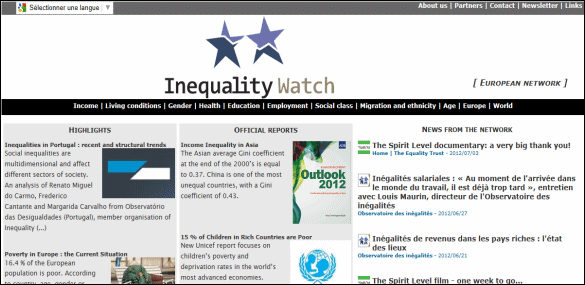SELECTED FOR YOU... JULY-AUGUST 2012:
 books of the month
books of the month
 site of the month
site of the month
 working papers
working papers
All the Selected for you
BOOKS OF THE MONTH
Econometric analysis of count data.
Analyse économétrique des données de comptage.
Winkelmann R.
Berlin : Springer Verlag : 2008 : 1 p .+ 333 p.
The book provides graduate students and researchers with an up-to-date survey of statistical and econometric techniques for the analysis of count data, with a focus on conditional distribution models. Proper count data probability models allow for rich inferences, both with respect to the stochastic count process that generated the data, and with respect to predicting the distribution of outcomes. The book starts with a presentation of the benchmark Poisson regression model. Alternative models address unobserved heterogeneity, state dependence, selectivity, endogeneity, underreporting, and clustered sampling. Testing and estimation is discussed from frequentist and Bayesian perspectives. Finally, applications are reviewed in fields such as economics, marketing, sociology, demography, and health sciences. The fifth edition contains several new topics, including copula functions, Poisson regression for non-counts, additional semi-parametric methods, and discrete factor models. Other sections have been reorganized, rewritten, and extended (4e de couverture).
Primary Care at a Glance - Hot Topics and New Insights.
Panorama des soins de santé primaires : points chauds et idées nouvelles.
Capelli O.
http://www.intechopen.com/about-intech.html : 2012 : 446p..
The content of the book is organized according to 5 attributes (accessibility, comprehensiveness, coordination, continuity and accountability), to give the reader an international overview of hot topics and new insights in Primary Care, all around the world.
SITE OF THE MONTH
Inequality watch
http://inequalitywatch.eu/
WORKING PAPERS
Health Care Insurance
Early Interventions and Disability Insurance: Experience from a Field Experiment 

Engstrom P., Hagglund P., Johansson P.
Bonn : IZA. 2012
This paper estimates the effects of early interventions in the Swedish sickness insurance system. The aim of the interventions is to screen and, further to, rehabilitate sick listed individuals. We find that the early interventions – in contrast to what is expected – increase the inflow into disability benefits by around 20 percent. In order to explain the results, we develop a simple theoretical model based on asymmetric information of the health status. The model predicts that the treatment effect is larger for individuals with low incentives to return to work. In order to test this prediction we estimate effects for sick listed employed and unemployed separately. Consistent with the model's prediction, we find that the effect is larger for the unemployed d than for the employed.
Health Economics
The cost of inaction on the social determinants of health 

Brown L., Thurecht L., Nepal B.
Camberra : National Centre for Social and Economic Modelling. 2012
The aim of this research is to provide an indication of the extent of the cost of Government inaction in developing policies and implementing strategies that would reduce socio-economic differences within the Australian population of working age (25-64 years) that give rise to health inequities. The cost of inaction is measured in terms of the loss of potential social and economic outcomes that might otherwise have accrued to socio-economically disadvantaged individuals if they had had the same health profile of more socio-economically advantaged Australians. For the purposes of this report, the contrast is made between those who are most socio-economically disadvantaged and those who are least disadvantaged defined in terms of household income, level of education, housing tenure and degree of social connectedness. Four types of key outcomes are considered:- the number of disadvantaged Australians of working age experiencing health inequity, - satisfaction with life, - economic outcomes (including employment, income from paid work, - savings to Government expenditure on social security payments and transfers) and savings to the health system. The Report aims to address five key questions: If the most socio-economically disadvantaged Australians of working age had the same self-reported health status profile of the least disadvantaged groups; how many more individuals would be in good health rather than poor health? If the most socio-economic- ally disadvantaged Australians of working age had the same prevalence of long-term health conditions as the least disadvantaged groups, how many more individuals would be free from chronic long-term illness? If individuals in the most socio-economically disadvantaged groups had the same health profile – in terms of self-assessed health status and long-term health conditions – of the least disadvantaged groups, how many more individuals would be satisfied with their life? If individual- s in the most socio-economically disadvantaged groups had the same health profile of the least disadvantaged groups, what improvements in employment status, income from paid work and reductions in government pensions, allowances and other public transfers are likely to be gained? If individuals in the most socio-economically disadvantaged groups had the same health profile of the least disadvantaged groups, what savings might occur to the health system in terms of reduced number of hospital separations, number of doctor- and medical-related services and prescribed medicines and associated costs to Government?
Health Geography
Addressing the social determinants of health: the urban dimension and the role of local government 

Copenhagen : OMS - Bureau régional de l'Europe. 2012
This report summarizes the evidence on the social determinants of health in the urban context, drawing on the findings of the global Commission on Social Determinants of Health and the European review of social determinants of health and the health divide. It also highlights how, through its leadership, local government can play a significant role in addressing these causes of health inequalities, by working across sectors and with civil society partners. This report provides a helpful overview of practices from across Europe, and identifies priority action areas and key implementation issues, to support and accelerate the growing interest of local governments in being sensitive and proactive in tackling inequities
Hospital
Hospital Staffing and Local Pay: an Investigation into the Impact of Local variations in the Competitiveness of Nurses Pay on the Staffing of Hospitals in France 

Delattre E., Combes J.B., Elliott B.
Cergy-Pontoise : Université de Cergy-Pontoise. 2012
Research has shown that where nurses' wages are regulated but wages in other sectors are not this results in spatial variations in the competitiveness of nurses pay and that in England these are correlated with spatial differences in nurses' labour supply. In France there is general regulation of wages and public hospitals compete with the private hospital and non hospital sectors for nurses. This paper constructs and employs a unique dataset on nurses pay and the characteristics of hospitals in France. It undertakes the first study of the impact of spatial wage differentials on nursing supply to French public hospitals. We show that nurse assistants' labour supply is sensitive to spatial wage differentials, the more competitive their pay the smaller the shortage of nurse assistants, and that registered nurses and nurse assistants labour supply are interdependent, the greater the supply of nurse assistants the greater the supply of registered nurses.
Innovative procedures: the key factor for hospital performance 

Gobillon L., Milcent C.
Paris : Ecole d'Economie de Paris. 2012
The role of innovative procedures in the mortality differences between university, non-teaching public and for-profit hospitals is investigated using a French exhaustive administrative dataset on patients admitted for heart attack. Mortality is roughly similar in the three types of hospitals after controlling for case-mix. For-profit hospitals treat the at-risk oldest patients more often with innovative procedures. Therefore, additionnally controlling for innovative procedures makes them having the highest mortality rate. Non-teaching public hospitals end up having the lowest mortality rate.
Risk-Adjusted Mortality, varieties of congestion and patient satisfaction in Turkish provincial general hospitals 

Davutyan N., Bilsen M., Tarcan M.
Munich : Munich Personal RepEc Archive. 2012
This paper analyzes the operational performance of 330 Turkish provincial general hospitals. To help improve performance on both input and output space, it adopts a directional distance approach. It treats a mortality based variable as bad output. Congested hospitals are those for whom the switch from strong to weak disposability of mortality is costly. Thus it is able to address the quality or adequacy of care issue. It identifies congested hospitals using 3 different direction vectors and derive the associated congestion inefficiency scores. For each case, it shows these scores are negatively related to patient satisfaction. It separates congested hospitals into two groups: (i) those requiring uniform sacrifice of good outputs and/or extra inputs in order to reduce mortality, and (ii) those that do not. The latter ones free up some inputs in addition to requiring extra amounts of other inputs and/or produce more of some outputs but less of others as the price of reducing mortality. The first group can be said to operate at capacity whereas the latter can be said to display negative marginal productivity. Patient dissatisfaction is demonstrably higher in the latter group of hospitals, whereas mortality reduction is positively related to patient satisfaction in capacity constrained hospitals. The first group is more likely to be located in emigrating whereas the second one in immigrating regions.
Social Health Inequalities
Do Income Gradients in Unhealthy Behaviours Explain Patterns of Health Inequalities ? 

Costa-Font J., Hernandez-Quevedo C., Jimenez-Rubio D.
London : London School of Economics and Political Science. 2012
More needs to be known about the origins of health inequalities and their measurement. This paper contributes by examining how the existence of income-related inequalities in unhealthy behaviours and more specificall- y, obesity (as a proxy for excessive food intake), alcohol intake and smoking might explain the persistence of health inequalities. We empirically examine data from two countries, England and Spain, which exhibit rising obesity levels, as well as smoking and alcohol use, drawing from unique health survey data. Furthermor- e, we carry out a sensitivity analysis of the influence of different robustness checks, including primarily, the definition of variables across national surveys, reporting bias associated with self-reported measures of lifestyle and the measurement of income-related inequalities in lifestyle factors across countries. The results document the persistence of income inequalities in obesity and tobacco use, which disproportionately concentrate among the relatively poor. However, we find that inequalities in alcohol consumption over time tend to concentrate among relatively richer individuals in both countries examined.
Prevention
The Determinants of Preventive Health Behavior: Literature Review and Research Perspectives 

Werle C.
Grenoble : Ecole de Management. 2012
People normally know they should follow a few preventive health behaviors in order to have a better and long life: to not smoke, to have a balanced diet low in fat and rich in vegetables and fruits, to exercise regularly, to avoid heavy drinking, to take medical screens for dangerous diseases, to have immunizations and to use seatbelts while driving. But even knowing that these measures can prevent serious future problems, some people do not adopt them. From a managerial and academic standpoint, it is important to understand the factors behind why people develop preventive health behaviors such as those cited above. On one hand, this is a primary question for public health when major diseases could be avoided by such simple actions. In addition, scant attention has been paid to this subject in the marketing literature in France
Prevention against equality? 

Fleurbaey M., Ponthiere G.
Paris : Ecole d'Economie. 2012
Common sense supports prevention policies aimed at improving survival prospects among the population. It is also widely acknowledged that an early death is a serious disadvantage, and that attention should be paid to the compensation of short-lived individuals. This paper re-examines the compatibility of those two concerns: prevention against early death and compensation for early death. We show that, under mild conditions, no social ordering on allocations can satisfy a concern for prevention and a concern for compensation. The reason is that if it is socially desirable to raise the number of survivors through preventio- n, it must also be, under costly prevention, desirable to deteriorate the living standards of the short-lived. We then explore two approaches to the prevention / compensation dilemma, and study the associated optimal allocation of resources.
Primary Health Care
Do Medical Doctors Respond to Economic Incentives? 

Andreassen S., Di Tommaso M.L., Strom S.
Oslo : CESIFO. 2012
A longitudinal analysis of married physicians labor supply is carried out on Norwegian data from 1997 to 1999. The model utilized for estimation implies that physicians can choose among 10 different job packages which are a combination of part time/full time, hospital/primary care, private/public sector, and not working. Their current choice is influenced by past available options due to a taste persistence parameter in the utility function. In the estimation we take into account the budget constraint, including all features of the tax system. Our results imply that an overall wage increase or a tax cut moves married physicians towards full time job packages, in particular to full time jobs in the private sector. But the overall and aggregate labor supply elasticities in the population of employed doctors are rather low compared to previous estimates.
The Economic Impact of Improvements in Primary Healthcare Performance 

Dahrouge S., Devlin R.A., Hogg C.
Ottawa : Canadian Health Services Research Foundation / Fondation Canadienne de la Recherche sur les Services de Santé. 2012
This report from the Canadian Health Services Research Foundation presents the results of four different approaches to evaluate the economic impact of enhancements to primary health care (PHC). These include a synthesis of the literature on the macro- and micro-economic effects of good health; a systematic review of the economic impact of incorporating a pharmacist into a PHC practice; a simulation exercise that evaluates the economic impact of improvements to influenza immunization rates for older adults; and a literature review of reductions in burden of illness associated with four specific enhancements to chronic disease management
Health Care System
Dimensions of health care system quality in Finland 

Paakkonen J., Seppala T.
Helsinki : Governement Institute for Economic Research. 2012
This paper evaluates the determinants of quality - cost relationship in primary health care. It first summarizes information from various indicators of care by principal component analysis (PCA), effectively producing quality of care indicators: accessibility, coverage and allocativ- e efficiency. It then regresses the costs of care against these indicators to evaluate their relationship. The results suggest that PCA may be used to produce quality of care indicators. Furthermore, the relationship between the costs and quality of care is complex. Better accessibility is reflected in higher costs, whereas the efficient allocation of resources will bring some cost savings.
Ageing
Private, social and self insurance for long term care: a political economy analysis 

Donder P.d., Pestiau P.
Toulouse : IDEI. 2011
We analyze the determinants of the demand for social, private and self-insurance for long-term care in an environment where agents differ in income, probability of becoming dependent and of receiving family help. Uniform social benefits are financed with a proportional income tax and are thus redistributive, while private insurance is actuarially fair. We obtain a rich pattern of insights, depending on whether private insurance is available or not, on its loading factor, and on the correlation between, on the one hand, income and risk, and, on the other hand, income and family help. Although the availability of private insurance decreases the demand for social insurance, it only affects a minority of agents so that the majority-chosen social insurance level remains unaffected. Family support crowds out the demand for both private and social insurance, and may even suppress any demand for private insurance. Family help cro wds out self-insurance only for agents whose demand for both social and private insurance is nil. A general increase in the probability of becoming dependent need not increase the demand for social insurance, since it decreases its return.
Long-Term Care, Altruism and Socialization 

Ponthiere G.
Paris : Ecole d'Economie de Paris. 2012
The public provision of long-term care (LTC) can replace family-provided LTC when adults are not sufficiently altruistic towards their elderly parents. But State intervention can also modify the transmission of values and reduce the long-run prevalence of family altruism in the population. That evolutionary effect questions the desirability of the LTC public provision. To characterize the optimal LTC policy, we develop a three-period OLG model where the population is divided into altruistic and non-altruistic agents, and where the transmission of (non) altruism takes place through a socialization process à la Bisin and Verdier (2001). The optimal short-run and long-run LTC policies are shown to differ, to an extent varying with the particular socialization mechanism at work.


